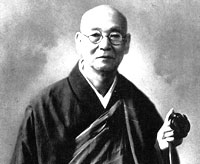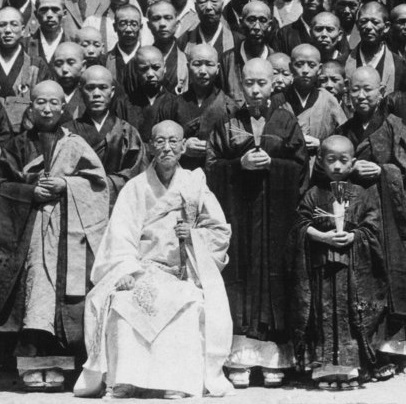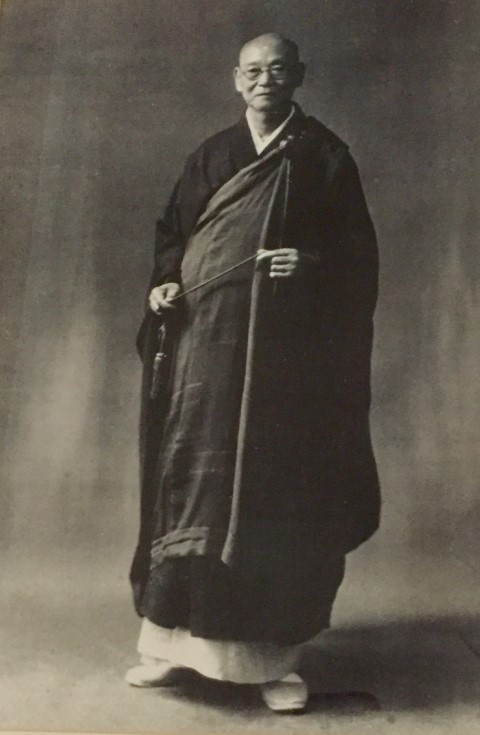Ian Kishizawa and his Teachers
Ancestors
 11-11-14
- Terebess site page for Kojun Noiri.
Kishizawa was Noiri's
master and Shunryu Suzuki's 2nd teacher.
11-11-14
- Terebess site page for Kojun Noiri.
Kishizawa was Noiri's
master and Shunryu Suzuki's 2nd teacher.
From Terebess site:
Ian Kishizawa
(1865-1955) - Soto Zen master, leading
interpreter of Dogen's Shobogenzo, and third abbot of Antai-ji. He
received dharma transmission from Nishiari Bokusan and succeeded Oka Sotan
and Genpo Kitano as official lecturer on the Shobogenzo at Eihei-ji. He
was the spiritual master of Kojun Noiri roshi. Shunryu
Suzuki roshi also
attended him at Eihei-ji monastery and later studied with him for many
years.
丘宗潭 Oka (Daijun) Sōtan (1860-1921) – 1st abbot of Antaiji; teacher of Kishizawa Ian, Gyokujun So-on, Eko Hashimoto, Sawaki Kōdō, Harada Sōgaku, et al.). "Oka Sōtan-rōshi … was the … source of power of all the teachers."
西有 瑾英 穆山 Nishiari (Kin'ei) Bokusan (1821-1910), the most prominent Meiji scholar of the Shobogenzo. He was a teacher of both Oka Sōtan and Kishizawa Ian, eventually becoming abbot of Sōji-ji.
 Some cuke links:
Some cuke links:
From Shunryu Suzuki CV: From March 1, 1932 to Jun 30, 1952: Studied Zen under Ian Kishizawa Roshi, who was one of the most excellent Zen Masters at that time in Japan.
Gabor Terebess writes: I am so happy to see your Kishizawa page!!! Maybe you remember Suzuki-roshi's most beautiful memories about his master, Kishizawa (though he doesn't say his name); here is the original lecture from your fantastic website (On my site I put the Hungarian version of the above text translated from ZMBM).:
from Bowing
Shunryu Suzuki Lecture
December 2, 1965
Thursday morning lecture
Los Altos
(title from book: Zen Mind, Beginner's Mind, p. 43)
[After demonstration of Buddhist bow] To bow is very important-- one of the important practice. By bow we can eliminate our selfish, self-centered idea. My teacher had hard skin on his forehead because he bowed and bowed and bowed so many times and he knew that he was very obstinate, stubborn fellow, so he bowed and bowed and bowed and he always heard his master's scolding voice. That is why he bowed. And he joined our order when he was thirty. For Japanese priest to join the order at the age of thirty is not early. So his master always called him ‘You lately-joined fellow'. He said, [Japanese phrase missing in transcript]. It means priest who joined our order when he is old. When we join order when we are young we have little -- it is easy to get rid of our selfishness. But when we have very stubborn, selfish idea it is rather hard to get rid of it. So he was always scolded because he joined our order so late. To scold does not mean slight people, or it does not mean to -- actually his teacher was not actually scolding him. His master loved him very much because of his stubborn character.
When he was seventy he said, “I -- when I was young I was like a tiger but now I am a cat.” He was very pleased to be a cat and to be like a cat. “Now I am cat”, he said. And to bow means to eliminate our self-centered idea. It is not so -- actually it is not so difficult -- easy -- and although it is difficult to try to get rid of it is very valuable practice. The result is not the point but effort to improve ourselves is valuable. There is no end in our practice.
12-17-14 -
Suzuki
tells a Kishizawa Story - an excerpt from a Suzuki lecture
 Kishizawa's
Calligraphy
Kishizawa's
Calligraphy
語句等: 渓声耳に入り月目を穿つ 華叟安
Text: "The sounds of a
valley stream enter your ears, and the moonlight clean."
Pen name: Suikyo, Haketsu-shi, Keishu-ken, Tekkan-ro, Shusui-ijin. Dharma
transmission from Nishiari Bokusan (1821-1910). He once was a teacher in a
elementary school. But at his age 32, he was ordained by Bokuzan Kin'ei.
He devoted his life to study and practice 'Shobo Genzo'. The founder of
Kyokuden-in in Shizuoka.


Two more selections found in the bowels of my computer. - dc
More Calligraphy by Ian Kishizawa


Calligraphy by Oka Sotan

I'd rather just link to Terebess page cause it's work to take all this material for this page, but it's important to be included in the Suzuki archive and not lost. That's also why I like for him and others to take material from my sites. - dc
Creating this page 11-11-14